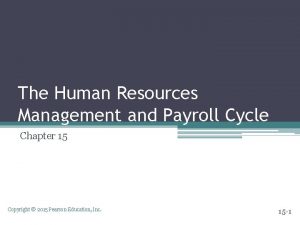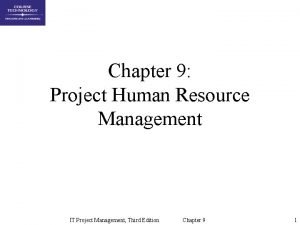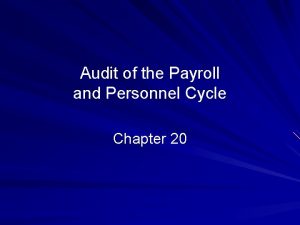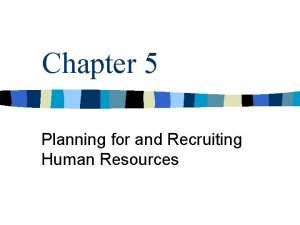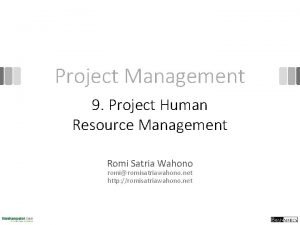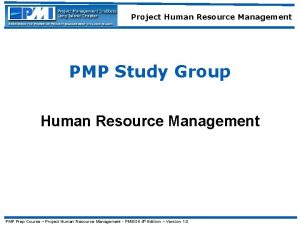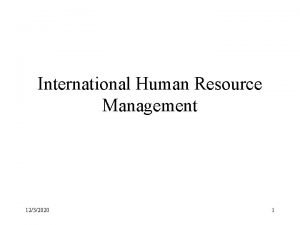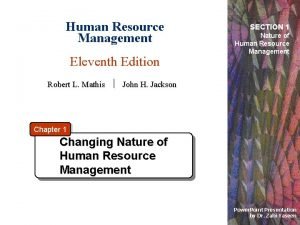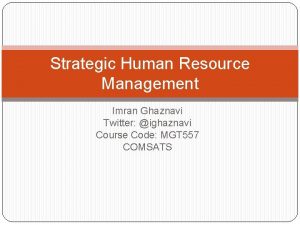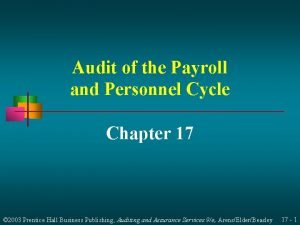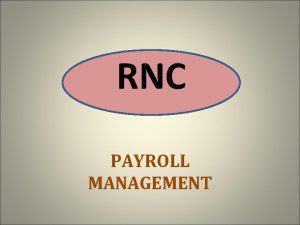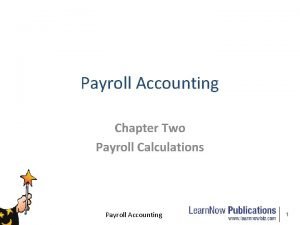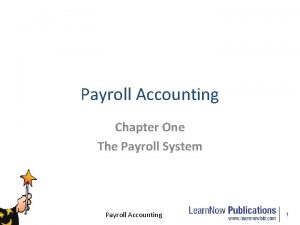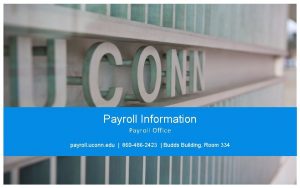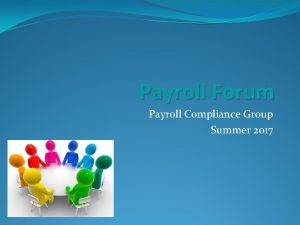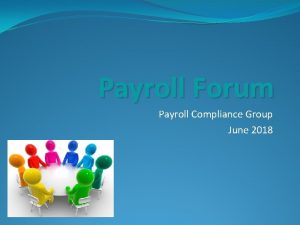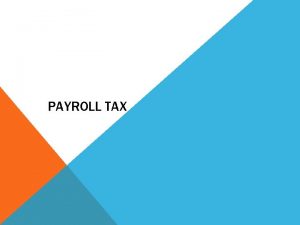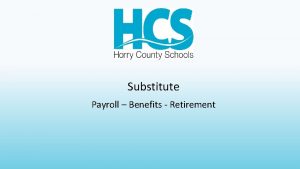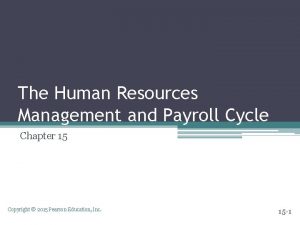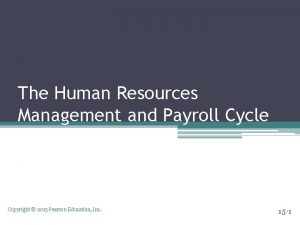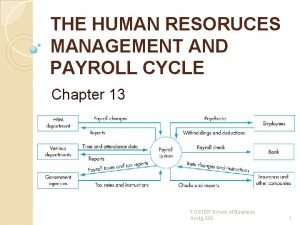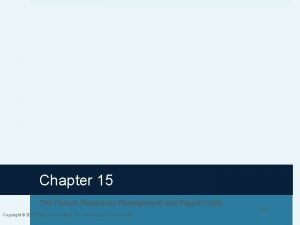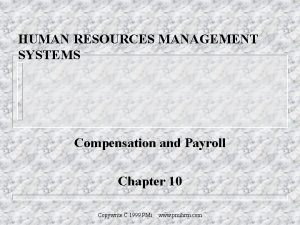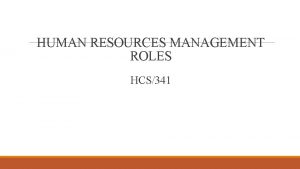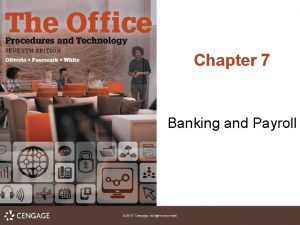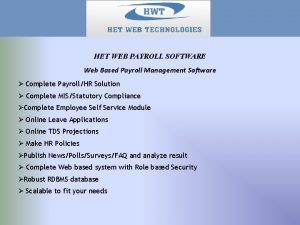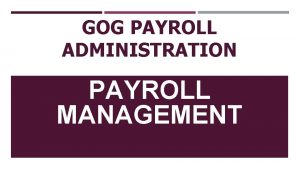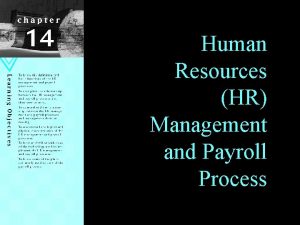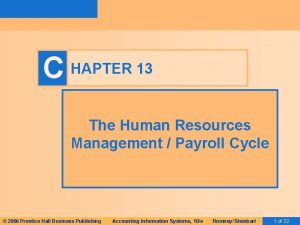The Human Resources Management and Payroll Cycle Chapter






























- Slides: 30

The Human Resources Management and Payroll Cycle Chapter 15 Copyright © 2015 Pearson Education, Inc. 15 -1

Learning Objectives • Describe the major business activities and related information processing operations performed in the human resources management (HRM)/payroll cycle. • Discuss the key decisions to be made in the HRM/payroll cycle and identify the information needed to make those decisions. • Identify the major threats in the HRM/payroll cycle and evaluate the adequacy of various internal control procedures for dealing with them. Copyright © 2015 Pearson Education, Inc. 15 -2

INTRODUCTION • Employees are an organization’s most valuable assets: ▫ Their knowledge and skills affect quality and quantity of goods and services. ▫ Labor costs are a major expense in generating revenues and a key cost driver. • The traditional AIS has not measured or reported on the status of a company’s human resources: ▫ Financial statements do not regard employees as assets. ▫ Under GAAP, the value of human services is not measured until they have been consumed. Copyright © 2015 Pearson Education, Inc.

Human Resource Management Process • • • Recruit and hire new employees Training Job assignment Compensation (payroll) Performance evaluation Discharge of employees (voluntary or involuntary) Copyright © 2015 Pearson Education, Inc. 15 -4

INTRODUCTION • There are five major sources of input to the payroll system: ▫ HRM department provides information about hirings, terminations, and pay-rate changes. ▫ Employees provide changes in discretionary deductions (e. g. , optional life insurance). ▫ Various departments provide data about the actual hours worked by employees. ▫ Government agencies provide tax rates and regulatory instructions. ▫ Insurance companies and other organizations provide instructions for calculating and remitting various withholdings. Copyright © 2015 Pearson Education, Inc.

INTRODUCTION • Principal outputs of the payroll system are checks: ▫ Employees receive individual paychecks. ▫ A payroll check is sent to the bank to transfer funds from the company’s regular account to its payroll account. ▫ Checks are issued to government agencies, insurance companies, etc. , to remit employee and employer taxes, insurance premiums, union dues, etc. • The payroll system also produces a variety of reports. Copyright © 2015 Pearson Education, Inc.

Payroll Cycle Activities 1. Update payroll master data 2. Validate time and attendance data • Source document: time sheets 3. Prepare payroll • Payroll register and deduction register 4. Disburse payroll 5. Disburse taxes and miscellaneous deductions Copyright © 2015 Pearson Education, Inc. 15 -7

1. Update Master Payroll Data • The HRM department provides information on new hires, terminations, changes in pay rates, and changes in discretionary withholdings. • Appropriate edit checks, such as validity checks on employee number and reasonableness tests are applied to all change transactions. • Changes must be entered in a timely manner and reflected in the next pay period. • Records of terminated employees should not be deleted immediately as some year-end reports (e. g. , W-2 s) require data on compensation for all employees during the year. Copyright © 2015 Pearson Education, Inc.

1. Update Master Payroll Data • The payroll department also receives notification of changes in tax rates and other payroll deductions from government agencies, insurers, unions, etc. • These changes occur periodically. Copyright © 2015 Pearson Education, Inc.

1. Update Master Payroll Data Threats Controls 1. 1 a. Segregation of duties b. Access controls 2 a. Data processing integrity controls b. Regular review of all changes to master payroll data Unauthorized changes to payroll master data 2. Inaccurate updating of master data Copyright © 2015 Pearson Education, Inc. 15 -10

2. Validate Time and Attendance Data • Some employees are paid on an hourly basis. • Some employees earn a fixed salary, e. g. , managers and professional staff. • Sales staff are often paid on a straight commission or base salary plus commission. • Increasingly, laborers may be paid partly on productivity. • Some management and employees may receive stock to motivate them to cut costs and improve service. Copyright © 2015 Pearson Education, Inc.

2. Validate Time and Attendance Data • The payroll system needs to link to the revenue cycle and other cycles to calculate these payments. • It’s also important to design bonus schemes with realistic, attainable goals that: ▫ Can be measured ▫ Are congruent with corporate objectives ▫ Are monitored by management for continued appropriateness ▫ Are legal Copyright © 2015 Pearson Education, Inc.

2. Validate Time and Attendance Data • How can information technology help? ▫ Collecting time and attendance data electronically, e. g. : �Badge readers �Electronic time clocks �Data entered on terminals �Touch-tone telephone logs ▫ Using edit checks to verify accuracy and reasonableness when the data are entered. Copyright © 2015 Pearson Education, Inc.

2. Validate Time and Attendance Data Threats Controls 1. 1 a. Source data automation for data capture b. Biometric authentication c. Segregation of duties d. Supervisory review Inaccurate time and attendance data Copyright © 2015 Pearson Education, Inc. 15 -14

3. Prepare Payroll • The employee’s department provides data about hours worked. • A supervisor confirms the data. • Pay rate information is obtained from the payroll master file. Copyright © 2015 Pearson Education, Inc.

3. Prepare Payroll • Procedures: ▫ The payroll transaction file is sorted by employee number (same sequence as master file). ▫ For each transaction, the payroll master file is read for pay rates, etc. , and gross pay is calculated. �Hourly Employees: Gross pay = (hours worked x wage rate) + Overtime + Bonuses �Salaried Employees: Gross pay = annual salary x fraction of year worked Copyright © 2015 Pearson Education, Inc.

3. Prepare Payroll ▫ Payroll deductions are summed and subtracted from gross pay to obtain net pay. There are two types of deductions: �Payroll tax withholdings �Voluntary deductions ▫ Year-to-date totals for gross pay, deductions, and net pay are calculated, and the master file is updated. Cumulative records are important because: �Social Security and other deductions cease or decline at certain levels. �The information will be needed for tax reports. Copyright © 2015 Pearson Education, Inc.

3. Prepare Payroll ▫ The following are printed: �Paychecks for employees--often accompanied by an earnings statement, which lists pay detail, current and year-to-date. �A payroll register which lists each employee’s gross pay, deductions, and net pay in a multicolumn format: �Is used to authorize the transfer of funds to the company’s payroll bank account. �May be accompanied by a deduction register, listing miscellaneous voluntary deductions for each employee. Copyright © 2015 Pearson Education, Inc.

3. Prepare Payroll Threats Controls 1. 1 a. Data processing integrity controls b. Supervisory review c. Earnings statements to employees d. Review of IRS guidelines Errors in processing payroll Copyright © 2015 Pearson Education, Inc. 15 -19

4. Disburse Payroll • Most employees are paid either by: ▫ Check ▫ Direct deposit ▫ In some industries, such as construction, cash payments may still be made, but does not provide good documentation Copyright © 2015 Pearson Education, Inc.

4. Disburse Payroll • Procedures: ▫ When paychecks have been prepared, the payroll register is sent to accounts payable for review and approval. ▫ A disbursement voucher is prepared to authorize transfer of funds from checking to the payroll bank account. �For control purposes, checks should not be drawn on the company’s regular bank account �A separate account is created for this purpose �Limits the company’s loss exposure �Makes it easier to reconcile payroll and detect paycheck forgeries Copyright © 2015 Pearson Education, Inc.

4. Disburse Payroll ▫ The approved disbursement voucher and payroll register are sent to the cashier. The cashier: �Reviews the documents. �Prepares and signs the payroll check to transfer the funds. �Reviews, signs, and distributes employee paychecks (which separates authorization and recording from distribution of checks). �Re-deposits unclaimed checks in the company’s bank account. �Sends a list of these paychecks to internal audit for investigation. �Returns the payroll register to payroll department, where it is filed with time cards and job time tickets. �Sends the disbursement voucher to accounting clerk to update general ledger. Copyright © 2015 Pearson Education, Inc.

4. Disburse Payroll • Efficiency Opportunity: Direct Deposit ▫ Direct deposit can improve efficiency and reduce costs of payroll processing �Employee receives a copy of the check and an earnings statement �Each bank receives a record of the payroll deposits for that bank via EDI. The record includes: �Employee number �Social Security number �Bank account number �Net pay amount Copyright © 2015 Pearson Education, Inc.

4. Disburse Payroll Threats Controls 1. 1 a. Restrict access to blank payroll checks and check signing machine b. Restrict access to EFT c. Prenumbering checks d. Supporting documentation e. Use separate account (imprest fund) f. Segregation of duties g. Restrict access to payroll master file h. Verification of employee identity i. Redeposit unclaimed checks 15 -24 Theft or fraudulent distribution of paychecks Copyright © 2015 Pearson Education, Inc.

5. Disburse Payroll Taxes • The employer pays some payroll taxes and employee benefits directly ▫ The employer withholds federal and state taxes from employee paycheck, along with Medicare tax, and the employee’s share of Social Security. ▫ May also withhold voluntary deductions such as union dues, United Way contributions, credit union savings, retirement contributions, etc. Copyright © 2015 Pearson Education, Inc.

5. Disburse Payroll Taxes • In addition, the employer pays: ▫ A matching amount of Social Security ▫ Federal and state unemployment taxes ▫ The employer share of health, disability, and life insurance premiums, as well as pension contributions • Some companies offer flexible benefit plans, sometimes called cafeteria-style benefit plans. ▫ These plans offer a menu of options. Copyright © 2015 Pearson Education, Inc.

5. Disburse Payroll Taxes Threats Controls 1. 1 a. Configure system to make automatic payments on time 2 a. Configure system to make automatic payments on time 3 a. Process integrity controls b. Supervisory review c. Employee review of earnings statements Failure to make required payments 2. Untimely payments 3. Inaccurate payments Copyright © 2015 Pearson Education, Inc. 15 -27

OUTSOURCING OPTIONS • Many entities outsource payroll and HRM to: ▫ Payroll service bureaus �Maintain the payroll master file and perform payroll processing activities ▫ Professional employer organizations (PEOs) �Perform the services of the payroll service bureau �Also administer and design employee benefit plans �Generally more expensive than payroll service bureaus Copyright © 2015 Pearson Education, Inc.

OUTSOURCING OPTIONS • When organizations outsource payroll processing, they send the service bureau or PEO at the end of each period: ▫ Personnel changes ▫ Employee time and attendance data • The service bureau or PEO then: ▫ Prepares paychecks, earnings statements, and a payroll register ▫ Periodically produces tax documents Copyright © 2015 Pearson Education, Inc.

Reasons to Outsource Payroll • Reduce costs ▫ Cost of processing and minimize errors • Broader range of benefits ▫ Administration of benefits • Free up computer resources Copyright © 2015 Pearson Education, Inc. 15 -30
 Payroll cycle activities
Payroll cycle activities Define human resource management and payroll cycle
Define human resource management and payroll cycle Payroll tax entries
Payroll tax entries Chapter 9 human resources management
Chapter 9 human resources management Human resource management chapter 1
Human resource management chapter 1 Chapter 9 human resources management
Chapter 9 human resources management Personnel cycle
Personnel cycle Operations management chapter 10
Operations management chapter 10 Human resource management final exam essay questions
Human resource management final exam essay questions Chapter 8 study guide human resources culture and diversity
Chapter 8 study guide human resources culture and diversity Chapter 8 human resources culture and diversity
Chapter 8 human resources culture and diversity Chapter 5 human resource planning and recruitment
Chapter 5 human resource planning and recruitment Project management human resources
Project management human resources What are physical resources
What are physical resources The importance of resource management
The importance of resource management Empower human resources
Empower human resources Human resource management definition
Human resource management definition Assess human resource requirements of a retail organization
Assess human resource requirements of a retail organization Weiterbildung human resources management
Weiterbildung human resources management Human resource management gaining a competitive advantage
Human resource management gaining a competitive advantage Hrm nature
Hrm nature Time management in human resource management
Time management in human resource management Concept of hrm
Concept of hrm Advantages of external recruitment
Advantages of external recruitment The role of psychology in human resources management
The role of psychology in human resources management Payroll and personnel cycle
Payroll and personnel cycle Difference between transforming and transformed resources
Difference between transforming and transformed resources Variable resources definition
Variable resources definition Chapter 27 human impact on earth resources
Chapter 27 human impact on earth resources Chapter 10 managing human resources
Chapter 10 managing human resources Cna chapter 8 human needs and human development
Cna chapter 8 human needs and human development
